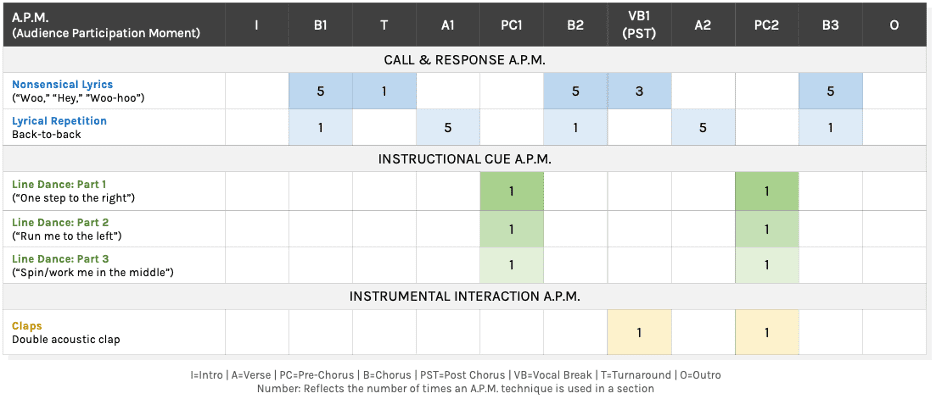“Texas Hold’em” exemplifies a song poised to deeply connect with audiences. Along with catchy melodies, compelling hooks, and a unique blend of country, folk, R&B, and pop, the song’s secret sauce is its ample and effective use of the Hit Songs Deconstructed A.P.M. technique.
An acronym for ‘audience participation moment,’ A.P.M.s incorporate elements designed to engage the audience in singing, clapping, and dancing. Among the most common are call and response, instructional cues, and instrumental interaction. “Texas Hold’em” distinguishes itself by integrating all of these throughout its runtime.

The first instance of the A.P.M. technique is the call and response between Beyoncé’s lead and the ensuing background vocals at the end of lines in the first chorus:
“This ain’t Texas (Woo)”
“Ain’t no hold ’em (Hey)”
“So lay your cards down, down, down, down”
“So park your Lexus (Woo)”
“And throw your keys up (Hey)”
“Stick around, ’round, ’round, ’round, ’round (Stick around)”
Along with providing the chorus with a fun, catchy, interactive spin, these background vocals cleverly foster familiarity within Beyoncé’s body of work while simultaneously pushing the boundaries of what she’s done before. While most of her hits include R&B and hip-hop-influenced end-of-line adlibs and repetitive vocals, the folk-leaning “woo”/”hey” shouts provide this familiar technique with a fresh spin while contributing to the song’s folk influence reminiscent of The Lumineers’ hit, “Ho Hey.”
Following an additional “whoo” shout in the one-bar turnaround that follows, the first verse continues with the call and response A.P.M. technique. However, to help heighten interest against the chorus, it shifts from the “whoo”/”hey” shouts to evocatively sung repetitive lyrics:
“There’s a tornado (There’s a tornado)”
“In my city (In my city)”
“Hit the basement (Hit the basement)”
“That sht ain’t pretty (That sht ain’t pretty)”
“Rugged whiskey (Rugged whiskey)”
“’Cause we survivin’ (‘Cause we survivin’)”
In addition to maintaining audience participation, this stylistic shift achieves a few other important things, including highlighting the song’s R&B influence against the country and folk influences, increasing familiarity with Beyoncé’s body of work, and further spotlighting Beyoncé’s vocal chops.
Following two consecutive sections of call and response A.P.M.s, the ensuing pre-chorus notably changes things up by shifting to the instructional lyric A.P.M. technique, where Beyoncé cues the listener on what to do:
“Ooh, one step to the right”
“We headed to the dive bar we always thought was nice”
“Ooh, run me to the left”
“Just work me in the middle boy, I can’t read your mind”
Along with preventing call and response redundancy in the scope of the song, the instructional lyric A.P.M. technique primes the song for a line dance, which greatly heightens its engagement value while putting it in an even more country-influenced space.
Following the second chorus, which possesses the same A.P.M. qualities as the first chorus in the song, the vocal break post-chorus introduces a unique A.P.M.-primed call and response between a super-catchy whistle hook and “woo-hoo” shout variation. However, the last two-syllable “woo-hoo” is omitted at the end of the section with a double acoustic clap taking its place. This cleverly keeps the listener locked into the section’s familiar structure while further amplifying their engagement with the shift to a new A.P.M.-ready element.
The second verse and pre-chorus feature the same A.P.M.s as their first occurrence counterparts, which accentuates structural familiarity in the scope of the song. However, the second pre-chorus also uniquely includes a double clap following the lyric “you run to the left,” which didn’t happen the first time around. This both contributes to the impact of the line dance while further strengthening listener engagement as the song progresses.
The third and final chorus also features the same A.P.M. structure as the previous choruses, further heightening the “hook center’s” familiarity factor. The outro that follows then omits overt A.P.M. qualities, which both prevents them from becoming overly redundant and puts the listener’s full focus on the stylistic shift to overt R&B as the song comes to a close on a more Beyoncé recognizable note.
From engaging call and response sequences to instructive lyrics and dynamic clap-driven interplay, “Texas Hold’em” skillfully employs A.P.M.s to draw listeners into a participatory role, masterfully transforming passive listening into an active, immersive experience.
View this technique in the techniques library here.